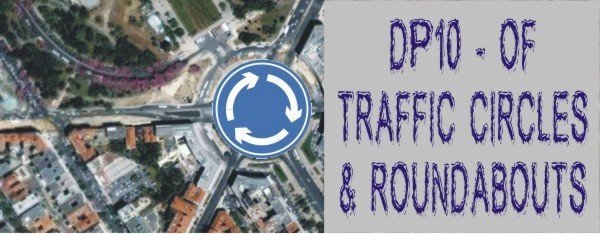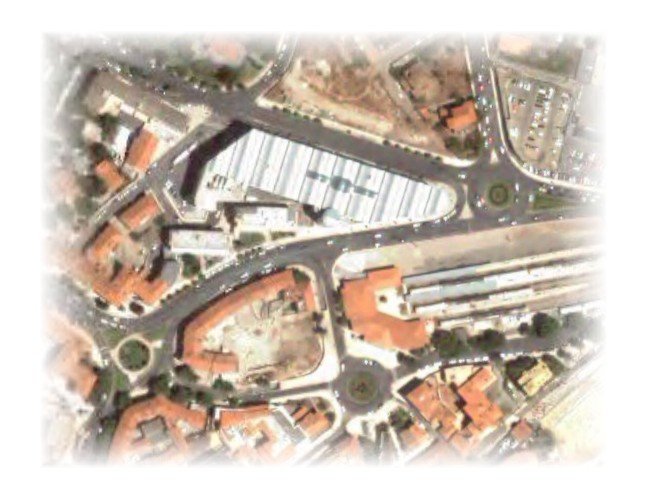
Traffic circles & roundabouts
are an integral part of our lives in our everyday commuting. They
were designed with a specific purpose in mind, which is to slow and
redistribute traffic. Their efficacy is sometimes doubtful,
especially when you are stuck in the middle of one or there is a
great big pile-up blocking the way.
Nowadays, when you start to see some of the “noveau sculptures”
that have mushroomed in the centres of these features, you start
wonder as to the architect’s or engineer’s taste in design. Love
them or hate them, you now have a cache planted smack bang in the
middle of one of these “noveau” circles.
For those of you interested in a
little more than the cache, please read on to learn a little about
the history and difference between traffic circles and
roundabouts.
Traffic
circles:
A traffic circle
is an intersection with a circular shape and, usually, a central
island. In some traffic circles two-way traffic is allowed within
the circle. It is much more common, however, that traffic is
allowed to go in one direction only around a central island. In
some traffic circles, entering roads are controlled by stop signs
or traffic signals. In other cases, traffic enters the circulatory
roadway by merging, sometimes at relatively high speeds.
Traditionally, traffic entering a circle had the right-of-way,
though many circles in New Jersey gave (and still give)
right-of-way to the primary roads. In modern traffic circles,
entering traffic must yield to traffic already in the circulatory
roadway.
History
French architect
Eugene Henard was designing one-way circular intersections
 as early as 1877.
American architect William Eno favored small traffic circles.
He designed New York City's famous Columbus Circle, which was
built in 1905. Other traffic circles were subsequently built
in the United States. Many were large diameter 'rotaries' that
enabled high speed merge and weave, and gave priority to the
traffic entering the circle. These designs were doomed to
failure for two primary reasons:
as early as 1877.
American architect William Eno favored small traffic circles.
He designed New York City's famous Columbus Circle, which was
built in 1905. Other traffic circles were subsequently built
in the United States. Many were large diameter 'rotaries' that
enabled high speed merge and weave, and gave priority to the
traffic entering the circle. These designs were doomed to
failure for two primary reasons:
- It takes a
large diameter circle to provide enough room for merging at speed.
Despite the fact that some of these circles were huge (many were in
excess of 100 meters or 328 feet in diameter), they weren't large
enough for high-speed merging.
- Giving
priority to entering traffic means that more vehicles can enter the
circulatory roadway than it can handle. The result is congestion
within the circle.
The experience
with traffic circles in the US was almost entirely negative,
characterized by high accident rates and congestion problems. By
the mid 1950s, construction of traffic circles had ceased entirely.
The experience with traffic circles in other countries wasn't much
better until the development of the modern roundabout in the United
Kingdom during the 1960s.
Difference
between roundabouts and traffic circles
Roundabouts
are sometimes referred to as traffic circles, but a
technical distinction was made between roundabouts and traffic
circles in the mid-1960s:
|
roundabout |
traffic
circle |
|
Entering
vehicles yield |
Stop sign,
stop signal, or giving priority to entering
vehicles |
|
Vehicles in
the roundabout have priority over the entering
vehicle |
Allow weaving
areas to resolve conflicted movement |
|
Use
deflection to maintain low speed operation |
Some large
circles provide straight path for higher speed |
|
No parking is
allowed |
Some large
circles permit parking within the circle |
|
Pedestrians
are (usually) prohibited from the central island |
Some large
circles allow pedestrians on central island |
|
All vehicles
circulate around the central island |
Mini-traffic
circles with left-turning vehicles passing to the left of the
central island. |
Roundabouts: History and safety
The first actual modern roundabout was constructed in New York
City, United States in 1904. However, the widespread use of
roundabouts began when British engineers reengineered the traffic
circle in the mid-1960s to overcome its limitations of capacity and
for safety issues. Unlike traffic circles, roundabouts operate with
yield control to give priority to circulating traffic and eliminate
much of the driver confusion associated with traffic circles and
driver wait associated with junctions that have traffic lights.
Roughly the same size as signalized intersections with the same
capacity, roundabouts also are significantly smaller in diameter
than traffic circles, separate incoming and outgoing traffic with
pedestrian islands and therefore encourage slower and safer speeds
(see traffic calming).
 Roundabouts are safer
than both traffic circles and traditional intersections—having
40% fewer vehicle collisions, 80% fewer injuries and 90% fewer
serious injuries and deaths (according to a study of a
sampling of roundabouts in the United States, compared with
the intersections they replaced). Roundabouts also
significantly reduce potential points of conflict between
pedestrians and motor vehicles and are therefore considered to
be safer for them. However, roundabouts, especially large fast
moving ones, are unpopular with, and can be dangerous for,
some cyclists. This problem is sometimes handled on larger
roundabouts by taking foot and bicycle traffic through a
series of underpasses.
Roundabouts are safer
than both traffic circles and traditional intersections—having
40% fewer vehicle collisions, 80% fewer injuries and 90% fewer
serious injuries and deaths (according to a study of a
sampling of roundabouts in the United States, compared with
the intersections they replaced). Roundabouts also
significantly reduce potential points of conflict between
pedestrians and motor vehicles and are therefore considered to
be safer for them. However, roundabouts, especially large fast
moving ones, are unpopular with, and can be dangerous for,
some cyclists. This problem is sometimes handled on larger
roundabouts by taking foot and bicycle traffic through a
series of underpasses.
In addition to
improved vehicle and pedestrian safety, and in spite of lower
speeds, roundabouts dramatically outperform traffic circles in
terms of vehicle throughput and, because a roundabout's circular
traffic is always moving, they outperform ordinary junctions with
traffic signals as well.
Happy hunting!
______________________________________________________________________________
Quer saber mais sobre o
Geocaching
em
Portugal?
Adere ao
grupo de discussão e visita os
sites
Geocaching@PT
,
GeoPorStats e os
mapas com a localização das caches
portuguesas
Would you like to know more about
Geocaching
in
Portugal?
Join the
discussion group and visit
Geocaching@PT
,
GeoPorStats and the
MAPSwith
the location of the portuguese
caches